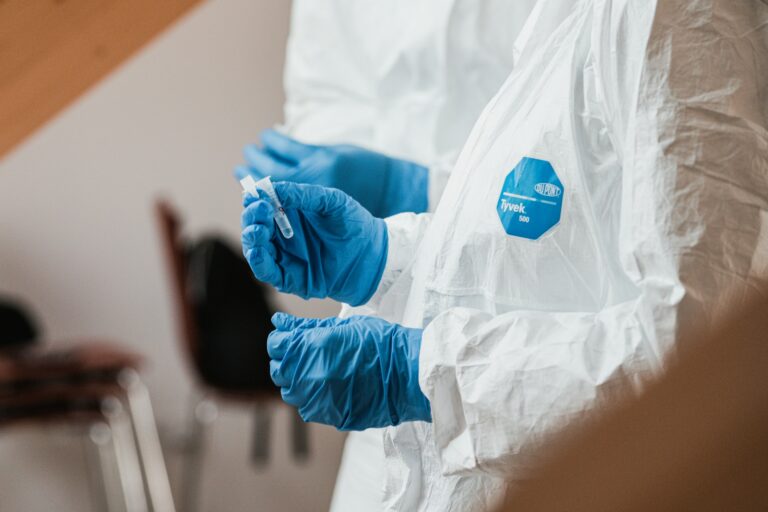Waste management in health and social care refers to the procedures and practices used to handle, collect, store, transport, treat, and dispose of all the waste generated during healthcare delivery. The purpose is to deal with waste safely, efficiently, and in ways that protect staff, patients, visitors, and the environment.
Every health and social care provider, from hospitals and clinics to care homes and community health settings, produces waste. This can range from everyday rubbish, like packaging and paperwork, to hazardous items such as used needles, dressings, and chemicals. Managing this waste is both a legal responsibility and a matter of keeping people safe.
Types of Waste Produced in Health and Social Care
Health and social care settings generate several types of waste. Understanding the different kinds makes it easier to work out what procedures should be in place.
- Clinical waste: This includes anything contaminated with blood or body fluids, such as dressings, swabs, gloves, and some medical instruments. It is potentially infectious.
- Sharps waste: All needles, syringes, scalpel blades, and other sharp instruments. These carry a risk of injury and infection.
- Cytotoxic waste: Waste containing substances used in cancer treatments, such as chemotherapy drugs. This is toxic.
- Pharmaceutical waste: Expired, unused, or contaminated medicines and vaccines.
- Chemical waste: Cleaning agents, laboratory reagents, and disinfectants.
- Radioactive waste: Left over from diagnostic or treatment procedures involving radiation.
- Non-clinical waste: Includes general rubbish like food scraps, paper, packaging, and other non-hazardous materials.
Segregation of these types at the source is a legal requirement. Mixing, for example, household waste with hazardous clinical items puts people and the environment at risk.
Legal Framework and Guidelines
Laws and official guidelines exist to make sure health and social care providers handle waste safely and responsibly.
The main rules are:
- The Health and Safety at Work etc. Act 1974
Requires employers to protect health, safety, and welfare at work, including management of dangerous waste. - The Hazardous Waste Regulations 2005
Special rules about handling, transporting, and disposing of waste that poses a risk to health or the environment. - The Environmental Protection Act 1990
Includes the duty of care for all waste. Organisations must store, describe, and dispose of waste properly. - Control of Substances Hazardous to Health (COSHH) Regulations 2002
Relates to substances which could harm health. - Department of Health guidance (e.g. Health Technical Memorandum 07-01)
Provides detailed best practice on waste management in healthcare.
Non-compliance can lead to prosecution, large fines, reputational damage, or closure of services. Responsible management is a legal expectation, not a choice.
Waste Segregation: Colour-Coding Systems
One way to manage waste safely is to separate it at the point where it is produced. Colour-coding makes this easier, so staff can instantly know which bin to use.
The main colour codes are:
- Orange: Infectious waste for treatment or incineration (e.g. swabs, dressings)
- Yellow: Infectious waste needing incineration only (e.g. anatomical waste, some medicines)
- Purple: Cytotoxic and cytostatic waste (chemotherapy drugs and associated materials)
- Red: For anatomical waste only
- Blue: Pharmaceutical waste (medicines, vaccines)
- Black: Domestic (non-hazardous) waste
- Tiger stripe (yellow with black): Offensive hygiene waste (e.g. incontinence pads)
Correct segregation protects everyone. Nurse’s stations, ward areas, clinics, and care homes all make use of these colour systems. Staff training, clear signage, and easy access to the right bins all help maintain safe segregation.
Handling and Storage
How waste is handled and stored is as important as how it is disposed of.
- Always wear gloves and use other personal protective equipment (PPE) for hazardous or infectious waste.
- Never compress waste bags with hands.
- Securely tie or seal bags when three-quarters full.
- Place bags or containers in designated, labelled, easy-to-clean areas.
- Store hazardous waste separately from general rubbish.
- Lock stores and restrict access only to trained staff.
- Sharps bins must be rigid, puncture-proof, and never filled past the line.
Waste storage areas are regularly cleaned and inspected for leaks, pests, or odours. Good storage reduces risk to staff, patients, and the environment, and helps with compliance during inspections.
Collection, Transport, and Final Disposal
Once waste is stored securely, collection and transport take the next priority.
Collection usually follows a set timetable. Staff hand over waste to authorised contractors.
- Waste vehicles are specially designed and regularly disinfected.
- Contractors hold licences for hazardous waste transport.
- Waste transfer notes track each movement for accountability.
Final disposal depends on the waste type:
- Incineration for infectious, pharmaceutical, cytotoxic, or anatomical waste
- Alternative treatments (e.g. autoclaving) for some infectious materials
- Secure landfill or energy recovery for some non-hazardous waste
- Specialist processes for radioactive or chemical waste
Records of disposal (often kept for years) show compliance with the law.
Training and Staff Responsibilities
All staff in health and social care settings play a part in safe waste management.
Training covers:
- Different waste categories and colour codes
- Use of PPE
- Safe handling, transport, and storage
- Accident, incident, and spill reporting
Training is refreshed often and forms part of induction for new staff.
Waste management teams and infection prevention leads monitor compliance. They run audits and share results with staff. Senior management is responsible for making sure proper procedures and training are in place.
Environmental Impact and Sustainability
Healthcare activities can create large quantities of waste. Handling it responsibly helps protect nature and public health.
Environmental issues include:
- Methane and carbon dioxide emissions from landfill sites
- Pollution from incinerators if materials are not sorted correctly
- Chemical spills contaminating water or soil
- Disposable plastics adding to environmental burdens
Modern policies encourage all sectors to reduce disposal by waste hierarchy:
- Prevention – avoiding waste in the first place
- Reuse – wherever possible (e.g. reusable textiles)
- Recycling – sorting non-hazardous items into recycling streams
- Recovery – using waste for energy generation
- Disposal – last resort
Healthcare organisations now buy more recyclable products, reduce single-use plastic, and encourage staff to use less. Green procurement is becoming a part of daily practice.
Risks of Poor Waste Management
Failing to manage waste properly leads to real harm.
Risks include:
- Staff suffering needle-stick or sharps injuries, possibly acquiring infections
- Contamination of surfaces, putting patients and visitors at risk
- Spread of infectious diseases (e.g. hepatitis B and C, HIV)
- Environmental pollution—affecting communities, animals, and water supply
- Prosecution, financial penalties, and loss of public confidence in services
Good protocols protect against these dangers.
Role of Infection Prevention and Control
Effective waste management forms a core part of infection prevention. Waste from patient care areas, especially from those with infectious diseases, is treated with extra caution.
Key points include:
- Using the correct bins for contaminated items
- Avoiding hand-contact with waste
- Cleaning bins and waste stores regularly
- Immediate disposal of sharps after use
Every member of staff, from cleaners to doctors, shares responsibility for keeping patients, colleagues, and themselves safe. This all relies on applying waste protocols every day.
Responsibilities of Service Users and Visitors
Service users and visitors play a small but helpful part. They need to:
- Follow signage about what to put in which bin
- Not touch medical or hazardous waste
- Tell staff about any spills or issues
This support helps maintain safe environments for everyone.
Monitoring, Audits, and Continuous Improvement
Frequent checks and audits are needed to keep standards high.
Waste management audits check:
- Correct segregation into colour-coded bins
- Safe handling and storage
- Up-to-date records tracking waste journeys
- Staff familiarity with procedures
Feedback from these audits prompts immediate corrective action. Services update protocols to reflect new research and technological improvements.
Examples of Good Practice
Several examples show good waste management in action:
- Hospitals using barcode tracking for waste bins
- Community clinics running ‘waste weeks’ to raise staff awareness
- Care homes switching from single-use items to reusable products
- Mental health units using visual signage to help all staff, including agency or temporary workers, apply correct disposal procedures
Learning from each other encourages safe and consistent waste management everywhere.
Final Thoughts
Managing waste in health and social care keeps everyone safe. It protects staff from injury, patients from infection, and the environment from harm. Through the right mix of legal compliance, training, clear procedures, segregation, and regular review, the sector builds a culture of safety.
Day-to-day attention to these details means health and social care settings can deliver their core purpose: safe, effective care for those who need it most. Every syringe disposed of correctly, every bin placed in the right spot, and every staff member trained can make a positive difference, not only to those inside the service, but to the wider world outside its doors.
Subscribe to Newsletter
Get the latest news and updates from Care Learning and be first to know about our free courses when they launch.







